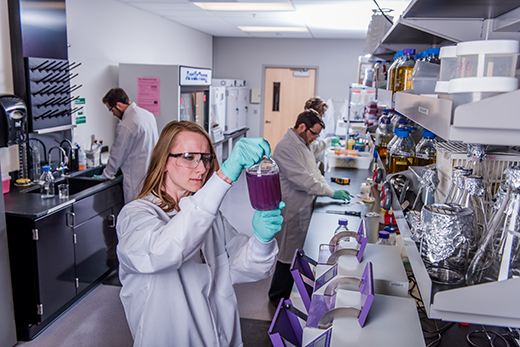Keep cool: Project looks at how temperature affects food safety of school lunches
Thursday, July 14, 2016

A research project housed at K-State Olathe looks at how temperature and cooling techniques used by schools when preparing and storing food affects the growth of foodborne pathogens. | Download this photo.
OLATHE — Researchers at Kansas State University and K-State Olathe are collaborating on a project that is using temperature to improve the safety of leftover food in schools and child care centers.
Sara Gragg, a K-State Olathe assistant professor of food science; Lindsay Beardall, a K-State Olathe master's student in food science, Lenexa; and Paola Paez, research associate professor of hospitality management at Kansas State University, are looking at how temperature and cooling techniques used by schools when preparing and storing food affects the growth of foodborne pathogens, such as Shiga toxin-producing Escherichia coli, or STEC.
"Often, schools and child care centers have leftover food that they save and use again in the next day or two," Gragg said. "That food needs to be cooled properly so that it does not become a food safety risk. Bacteria like to grow in food during the cooling process if the food is not cooled rapidly enough. We want to prevent that growth."
The multiyear project recently entered its second phase. The project is part of the expansive research portfolio at Kansas State University's Center of Excellence for Food Safety Research in Child Nutrition Programs, of which both Gragg and Paez are researchers.
The center began in 2011 with funding from the U.S. Department of Agriculture's Food and Nutrition Services' Office of Food Safety, and is led by faculty from the departments of hospitality management and food, nutrition, dietetics and health. Kansas State University experts and leaders in food safety and nutrition conduct research that helps provide a foundation for science-based decisions on food safety for the more than 2.2 billion meals and snacks served through various federal-funded child nutrition programs. Research from the center influences the National School Lunch Program, School Breakfast Program, Summer Food Service, After School Snack Programs and the Child, Adult Care Feeding Programs and more.
While the center and a majority of its research projects are based in Manhattan, Kansas, the cooling project is housed at K-State Olathe, which has a commercial food service kitchen as well as a specially designed food safety lab with an adjacent walk-in cooler and freezer.
Researchers use the kitchen to cook rice, chili, taco meat and marinara sauce — staples of child nutrition programs — in accordance to how they would be prepared in the school food service setting. The prepared food is then taken to the lab, inoculated and then cooled with a variety of food cooling techniques used in schools, such as being stored in a walk-in cooler or freezer.
Because pathogens cannot be introduced to the walk-in cooler, researchers are working with surrogate microorganisms that simulate real pathogens, Gragg said. This includes a biosafety level-1 E. coli.
"We're essentially using noninfectious bacteria to simulate the behavior of their infectious counterparts," Gragg said. "This provides us with the flexibility to study harmful pathogens under the same conditions they would appear in food at school cafeterias, but without the risk of infection."
Once the food is cooled, researchers then study bacterial populations in the food over the course of 24 hours.
Gragg and Paez will use the findings to make recommendations about safer food cooling techniques, which may influence future food safety policies and regulations. Currently, the team has developed four scientific posters about its findings.
An upcoming third phase of the cooling project may introduce another common foodborne pathogen that the researchers will study.
Additional projects under the Center of Excellence for Food Safety Research in Child Nutrition Programs include:
• A study that looks at how school nutrition employees can change their behaviors and attitudes to improve food safety. This includes using a storytelling-based approach to influence changes;
• Incorporating a food safety approach into the nation's efforts to reduce wasted food in schools by 50 percent by 2030;
• A simulation study about meals used on field trips that looks at using time as a public health control to reduce the risk of foodborne pathogen growth;
• Looking at what food safety regulations are in place for in-home and business-based child care centers across the U.S. and what standardizations can be made from state to state;
• Multiple training programs, including Serving Up Science, in which 190 school nutrition practitioners from 48 U.S. states have participated in the program.
"Kansas State University has many scientists who have experience in food safety and childhood nutrition as well as many unique facilities that advance this research," Paez said. "The Center of Excellence for Food Safety Research in Child Nutrition Programs combines that expertise and those facilities that stretch across the university's multiple campuses into a powerful and knowledgeable food safety source for the nation."
